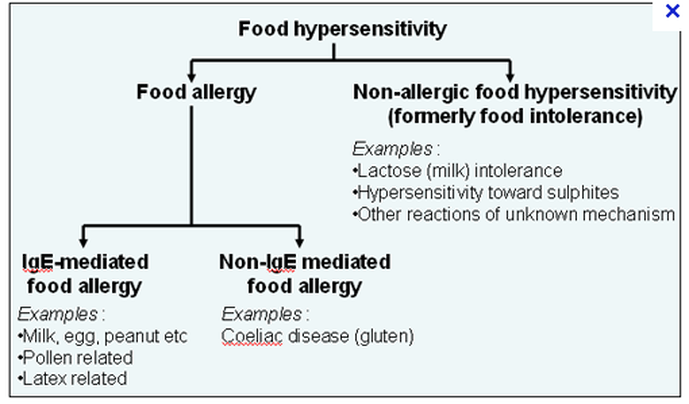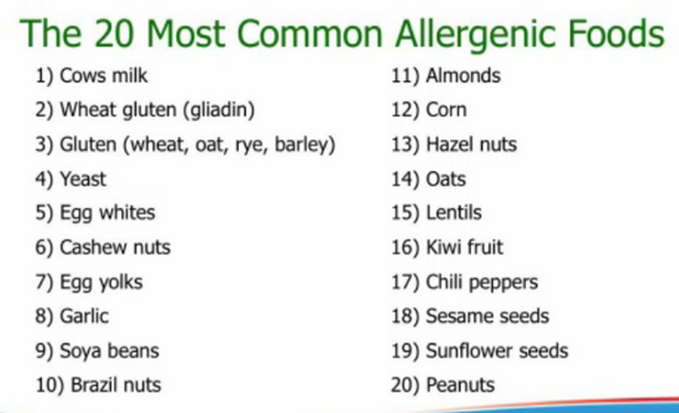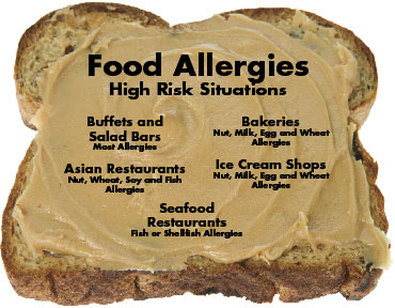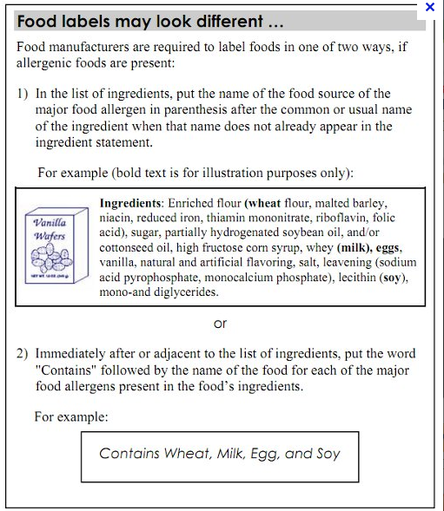Mechanisms of Food Sensitivity

.
Foods to Avoid

Sulphite Sensitivity
Allergy or Sensitivity ?
True allergic reactions only occur after exposure to an allergenic protein.
Since sulphites are not proteins, a reaction to sulphites is not due to an allergy but to a sensitivity.
Regardless, a sulphite sensitive person may experience the same life-threatening symptoms during a reaction sulphites as occurs during an allergic reaction.
Where sulphites are used.
Sulphites are added to some processed foods to maintain colour, prolong shelf life and prevent the growth of microorganisms.
Sulphites are also sometimes used to bleach food starches and are used in the production of some packaging materials, such as cellophane.
The use of sulphites in food is regulated under Canadian law.
Read the Labels
Read ingredient lists carefully and learn to identify other names for sulphites, such as potassium bisulphite.
Tree Nut Allergy
Some tree nuts are considered to be priority allergens in Canada.
These are almonds, Brazil nuts, cashews, hazelnuts, macadamia nuts, pecans, pine nuts, pistachios and walnuts.
There are other tree nuts not included in this list that can also cause allergic reactions in rare instances.
Tree nuts and peanuts.
People with tree nut allergies may be allergic to a single type of tree nut or they may be allergic to two or more different tree nuts.
Although the peanut is part of the legume family and not a tree nut, some people with tree nut allergies also react to peanuts.
Wheat Allergy
Wheat Allergy or Celiac Disease?
There are important differences between a wheat allergy and celiac disease.
A wheat allergy causes a person’s immune system to react abnormally to proteins found only in wheat.
Celiac disease is a disorder that triggers abnormal immune reactions to the gluten found in wheat (including kamut and spelt), barley, rye, and triticale.
For people with celiac disease, eating food with gluten can damage the lining of their small intestines, thus impairing their ability to absorb nutrients.
This can lead to diarrhea, weight loss, malnutrition and other serious health consequences.
Easy Guidelines on Fighting Food Allergy through Allergens-Free Diet

Some people are not aware that they have food allergy. It can be difficult to diagnose especially if allergic reactions are not apparent before. Symptoms of food allergy only appear if you exceed the tolerable amount of foods you are allergic to.
Food allergy lets your body react as if some foods are harmful. The immune system of the body then creates antibodies for fighting back food allergens which triggers the food allergy. Once the person eats the food, touches the food, or even inhales its particles, chemicals including histamine are released by the body to protect it from allergens. Allergic symptoms can affect your cardiovascular system, skin, gastrointestinal tract, or respiratory system. Food allergy symptoms are characterized by wheezing, abdominal pain, swelling, itchiness in the throat, tongue, or lips, itchy skin rashes, and runny nose.
Food allergies need to follow special diets. These diets do not contain food allergens as much as possible. It is advised to consult your doctor or dietitian especially if you want to eliminate some types of food from your original diet or begin a specialized diet. It is because you might need some adjustments on the new meal plan or replace any lost nutrients by taking nutritional supplements.
1. Milk allergy diets. You need to eliminate milk and dairy products containing milk. These are good sources of Vitamin D and calcium. So it is necessary to replace it with other kinds of food such as soy products, spinach, and broccoli, also enriched with these nutrients. The labeled ingredients of the products must be always checked. You can also use almond, rice, or soy milk, instead of cow’s milk. Non-dairy goods which include some margarines, cheese, yogurt, chocolate, and ice cream.
2. Egg allergy diets. Young children, adults, and infants are more prone to egg allergies. Elimination of eggs and other products with egg contents is needed. Also check labels carefully because some egg alternatives has egg white contents.
.

3. Peanut allergy diets.
Peanut allergies are one of the most fatal and are potentially serious among all types of food allergies. It contains food allergens most common for triggering allergic reactions. Most commercial foods such as ethnic foods, candy, and baked foods contain peanuts, especially if prepared only by one manufacturer.
4. Tree nuts allergy diets. All products with tree nuts ingredients must be totally avoided even though only one nut triggers your allergic reactions. Some shampoos and lotions also contain tree nuts. Carefully check the product labels.
5. Fish allergy diet. Fish have different species but contains similar proteins. You need to eliminate all kinds of fish from your diet, except if your allergist has already determined the specie that triggers your food allergy. It is also advisable not to visit seafood restaurants.
6. Shellfish allergy diets. Shellfish have different species but contains similar proteins. You need to eliminate all kinds of shellfish from your diet, except if your allergist has already determined the specie that triggers your food allergy.
7. Soy allergy diets. Soybeans are considered legumes which include kidney beans, navy beans, black beans, string beans, chickpeas, pinto beans, peanuts, carob, licorice, and lentils. This is widely used for processing foods, so make sure to avoid such products.
8. Wheat allergy diets. Wheat proteins are called gluten and wheat made foods are considered as American diet staples, which you need to avoid. Read the labels of the products carefully.
Never forget these diet guidelines to fight food allergies successfully. After all nothing beats caution and preparedness.
Peanut allergies are one of the most fatal and are potentially serious among all types of food allergies. It contains food allergens most common for triggering allergic reactions. Most commercial foods such as ethnic foods, candy, and baked foods contain peanuts, especially if prepared only by one manufacturer.
4. Tree nuts allergy diets. All products with tree nuts ingredients must be totally avoided even though only one nut triggers your allergic reactions. Some shampoos and lotions also contain tree nuts. Carefully check the product labels.
5. Fish allergy diet. Fish have different species but contains similar proteins. You need to eliminate all kinds of fish from your diet, except if your allergist has already determined the specie that triggers your food allergy. It is also advisable not to visit seafood restaurants.
6. Shellfish allergy diets. Shellfish have different species but contains similar proteins. You need to eliminate all kinds of shellfish from your diet, except if your allergist has already determined the specie that triggers your food allergy.
7. Soy allergy diets. Soybeans are considered legumes which include kidney beans, navy beans, black beans, string beans, chickpeas, pinto beans, peanuts, carob, licorice, and lentils. This is widely used for processing foods, so make sure to avoid such products.
8. Wheat allergy diets. Wheat proteins are called gluten and wheat made foods are considered as American diet staples, which you need to avoid. Read the labels of the products carefully.
Never forget these diet guidelines to fight food allergies successfully. After all nothing beats caution and preparedness.